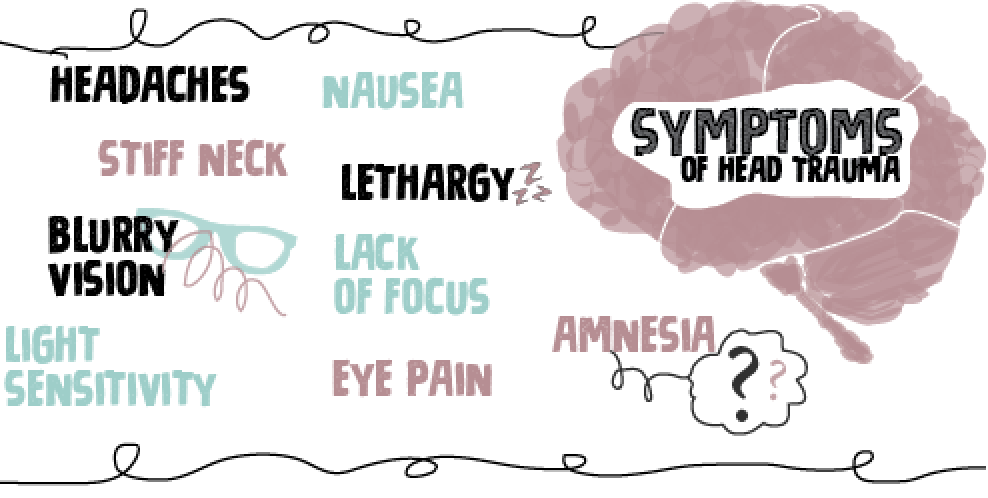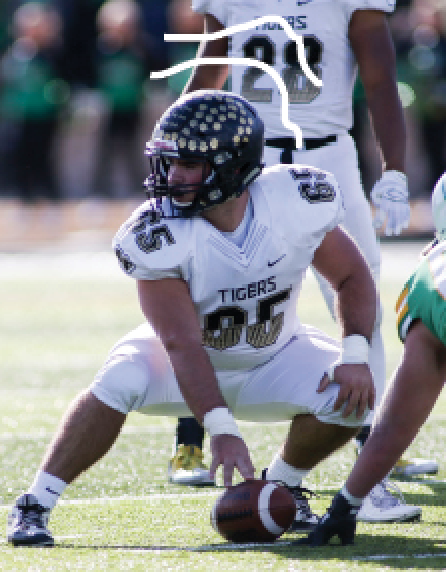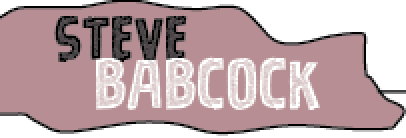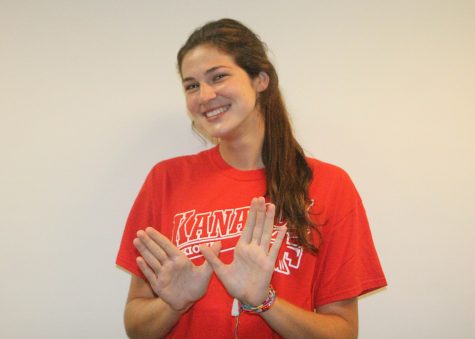The Invisible Injury
Does our district foster conversation on the importance of concussion awareness?
Every year in the United States, over 300,000 concussions are reported among high school and college-aged individuals. Car accidents make up the highest percent of head injuries — roughly 14 percent — with sports following closely behind, causing 8.9 percent of high school head injuries in America last year.
Concussion instances in teenagers have risen by more than 200 percent in the past decade. Even with these rates of incidents, some students and athletes across the U.S. and at Blue Valley still ignore or do not recognize the dangers of the invisible injury — a trauma that, due to inadequate treatment, affects and inhibits about 5.3 million American adults in their daily lives.
The Tiger Print investigated this phenomenon in our school and district, as we spoke to administrators and students about their experiences with dealing with head trauma in an effort to foster conversation about the district protocol and possible consequences of improper concussion treatment.

Concussions can happen anytime an object comes into contact with a person’s head — simple, everyday activities can cause concussions. The highest rates of high school concussion incidents from sports are seen in full-contact athletics such as football, soccer and hockey.
According to BV District Athletic Director Lane Green, the district and individual schools are extremely committed to preventing and resolving concussions.
“We place a very high priority on making sure all of our coaches are educated with regards to concussions — that they understand the signs [and] symptoms of concussions, that they understand what to do if a student-athlete has a concussion and can act on it,” Green said. “We place a very high level of importance on making sure everyone in the sports community handles concussions the right way.”
The school district has a specific, detail-oriented protocol for athletes with possible concussions. This procedure enables all BV institutions, including middle schools, to treat concussions in the exact same manner. Athletic trainer Caitlin Truhe said BV’s system is similar to those of other area districts as well.
 “If an athlete sustains a concussion or we are concerned that an athlete has sustained a concussion, they will be seen by the school nurse or myself,” Truhe said. “They will then be referred to a physician. If the physician diagnoses them with a concussion, they are supposed to follow the academic protocol and exercise program that the doctor prescribes. At the end they are required to complete a five-step process to return to play.”
“If an athlete sustains a concussion or we are concerned that an athlete has sustained a concussion, they will be seen by the school nurse or myself,” Truhe said. “They will then be referred to a physician. If the physician diagnoses them with a concussion, they are supposed to follow the academic protocol and exercise program that the doctor prescribes. At the end they are required to complete a five-step process to return to play.”
The imPACT test — the nationally-recognized tool for diagnosing concussions that requires athletes to identify patterns, memorize numbers and think creatively — is another tool used by the district athletic trainers. This exam is done on a computer and functions as a baseline for the athlete.
Once a concussion is suspected, the student will retake the imPACT test to compare the results and determine if a head injury was sustained based on the differences of the scores.
“When you don’t experience physical symptoms [such as headaches and nausea], you might think your concussion is gone,” Truhe said. “But, you might still have limitations cognitively with learning and retaining information. That is the danger in concussions — the things you can’t necessarily feel.”
According to Green, a student or trainer cannot rely on the imPACT test alone as sole evidence of a concussion, but it is simply another accessory the district utilizes to ensure the safety of its athletes.
“The challenge with concussions is there’s no true outward sign,” Green said. “There’s not a bone sticking out of a leg, there’s not a bandage and there’s no blood or a cut. There’s nothing visible on the surface that will tell somebody you’ve had a concussion. Diagnosing concussions is primarily based on looking at the symptoms that a student athlete might explain at that time. The imPACT test is somewhat concrete information because it compares how a student did after they’ve had their suspected concussion to how well they did the first time around. It’s a good tool, but it’s not the only tool.”
Green said the district looks to employ the finest athletic trainers to assist students, coaches and parents.
“At Blue Valley, you have Caitlin Truhe [as your athletic trainer],” he said. “She is very, very up-to-date on the signs and symptoms of concussions. She does a great job helping the coaches and the athletes determine if the athlete had a concussion — you are in great hands.”
Senior Zack Willis sustained a concussion from playing football during the State championship game against Derby in 2016.
“I started to get dizzy, and things got a little blurry,” Willis said.
Because he is a center on the team, he got his injury on the line.
“A linebacker kept running at me and beating me with his head — it was just play, after play, after play,” he said. “Somewhere along the way, I had taken too many hits against the head.”
He said he could immediately tell during the game what was wrong.
“After about 8 or 10 hits, my head was pounding — I just knew,” he said.
However, instead of taking himself out of the game, Willis continued to play.
“It was the State championship, and I [had] been waiting and working for three years for that opportunity,” he said. “There was no way I was sitting out of that game.”
While in recovery, he said he couldn’t participate in a number of activities he had previously been able to.
“I was in weights class, and [usually] I like to play games,” he said. “I couldn’t really do anything. I couldn’t run, I couldn’t lift weights — anything like that. I was just getting headaches and was dizzy. I took about a week and a half off before I started running again.”
After playing through his concussion, Willis said he is lucky to have not experienced any further problems or complications with his mental health.
“I experienced symptoms for about two weeks after the game,” Willis said. “After that, I was pretty fine — back to normal.”

Last year, junior Steve Babcock was heavily involved with football and hockey, two of the most concussion-prone sports. He said he regularly took hits to the head due to colliding with other athletes on the turf and on the ice.
Steve said concussions had simply become another part of sports to him.
“I’ve had overall six hospitalized concussions,” he said. “[The doctors] think I’ve had around 10 total. I chose to continue playing without going to the doctors for a while, so it was probably more.”
Due to these multiple head injuries, Steve has chosen to no longer participate in sports. Plagued with constant headaches, Steve said he cannot function normally in a traditional school environment anymore.
“I can’t concentrate in class,” he said. “I have only been able to handle going to two classes a day for about three months now. I have to do a pass-fail option in pretty much every class. If I even try to think of a math problem or write it down, [my] head is in pain. Reading hurts. Anything that you do hurts. Looking at the computer hurts.”
Steve said he was able to play through the concussions because he didn’t tell his coach about his symptoms or the pain he was experiencing — which has caused lasting damage. He said looking back, he wishes he realized the outcome of continuing to play with head trauma.
“I really should have taken it more seriously,” Steve said. “I should’ve also quit sports earlier. Looking back, it would’ve been good to tell [someone].”
After his third concussion, his symptoms became too difficult to hide, and he began to tell the truth about his condition. If he had continued to lie, he said he might still be playing today.
“Our trainer, Caitlin, put me on protocol my sophomore year and helped me recover,” he said. “I could’ve kept playing right now if I really wanted to.”
After his football career ended, he remained active in hockey for another year. Eventually it all became too much, and the concern about his health grew exponentially. Steve now visits a neurologist regularly, and Scott Babcock, Steve’s father, said some of his recent test results are alarming.
“Steve’s brain scans appeared ‘borderline normal’ according to the doctors,” Scott said. “This means he potentially has some brain damage. His brain development has halted in some areas, before the parts were fully developed.”
Steve has also experienced startling effects to his energy levels, due to his new development of sleep apnea. Recently, Steve participated in a sleep study, and the results made it clear that the concussions have deeply affected his body and brain.
“Steve was waking up over 40 times per hour,” Scott said. “He actually stops breathing for over 20 seconds, six to nine times per hour.”
Steve is now well aware of the consequences of his actions. He said he advises other students to be honest about their health because it could cost them their future.
“If you have multiple concussions, you should stop playing,” Steve said. “You should be honest about how you feel. If you feel you should quit, then quit.
Although frequently associated with sports, concussions can occur nearly anywhere.
Due to a car accident on a night in September of 2016, junior Grace Marquardt suffered a concussion while sitting in the passenger seat of a vehicle. Marquardt was not wearing a seatbelt at the time of the incident.
“The driver [of the car I was in] went over a median [in a parking lot],” she said. “The car went up and shot all the way down, and my head hit the ceiling [handlebar].”
Marquardt said she initially lied about showing characteristics of a concussion.
“It’s a stupid thing,” she said. “I thought if I didn’t think about [my symptoms] and nobody babied me about them, they would just go away.”
Because she downplayed her symptoms, Marquardt said she was unaware of her concussion after visiting an emergency room that night.

“[The accident] happened on a Saturday,” she said. “I went back to school on Monday, and I didn’t know that I had [a concussion yet]. I was sent to the nurse by my teacher because I was dizzy and [was] falling over.”
After diagnosis, she wasn’t able to attend a full day of school for six weeks due to the late recognition of her concussion.
Marquardt said she still suffers a few symptoms that are affecting her life in more negative ways.
“I get dizzy sometimes, I get headaches about five times a day and it’s been months since the incident,” she said. “I am also experiencing memory problems.”
Marquardt said she is concerned about the concussion affecting her life in the future.
“[My biggest worry is that] my head won’t heal fully, the headaches won’t go away and it’ll keep me from doing more things,” she said. “There’s a lot I’ve had to miss out on because of [my concussion].”
The BV district, with such a specific and careful protocol, still is plagued by athletes who value the game over their personal health. Even non-athlete students who end up with head injuries still can be hesitant to seek aid.
The district can implement as many policies to prevent, treat and rehabilitate concussions, with the most informed, careful coaches and teachers, but until the athletes and students realize the danger of playing through a concussion or not seeking help, they still have the power to lie through their teeth, Green said.
Green said students, especially athletes, cannot afford to ignore the possible dangers of any head injury.
“They’re playing with fire,” he said. “A concussion in and of itself, if treated, is not a terrible thing. However, what is really, really  bad is if an athlete gets another concussion before the first concussion was completely healed. That’s called Second-Impact Syndrome. We see it happen across every school. Everything — I mean everything — is at risk if you withhold the fact that you feel you might have a concussion from your coach. If you get a second concussion, it can result in anything from permanent impairment in terms of memory function, motor skills and other bodily functions all the way to death.”
bad is if an athlete gets another concussion before the first concussion was completely healed. That’s called Second-Impact Syndrome. We see it happen across every school. Everything — I mean everything — is at risk if you withhold the fact that you feel you might have a concussion from your coach. If you get a second concussion, it can result in anything from permanent impairment in terms of memory function, motor skills and other bodily functions all the way to death.”
According to Green and Truhe, students must approach concussions as a professional matter — concussions must be treated as abruptly and as seriously as a broken leg.
Green said because of the rise in student deaths relating to concussions, those in the area cannot afford to deal with the consequences due to a choice to play in a game or to go to school with a head injury in fear of missing a game or class.
“It’s not that those students [who did not report their concussions] did anything wrong — they might not have known they even had a concussion to start out with — but they cannot lie. The bottom line is if you feel dizzy, if you feel a sensitivity to light, if you feel any type of memory loss or headaches, inability to focus on your studies, it is imperative that you let your coach or the athletic trainer know because the risks are way, way too serious, and it can be too costly a mistake.”

Courtney Carpenter is the co-editor of “The Tiger Print.” She enjoys writing feature stories and meeting new people. Courtney loves playing volleyball,...

Anna Gyori is a senior and a staff writer for “The Tiger Print.” She likes to write news articles, particularly on the international scale. At school,...

Alli Williams is a co-editor in chief for “The Tiger Print.” She works as an assistant teacher at a math tutoring business. Her favorite part of journalism...

Olivia Gurley is a junior and a photographer for “The Tiger Print.” She loves to play basketball and has a passion for photography. One of her favorite...



